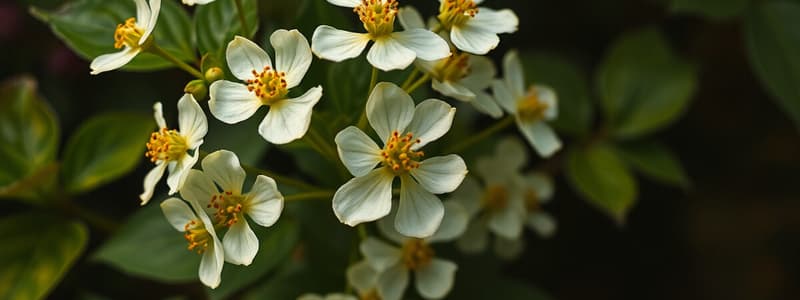Podcast
Questions and Answers
Which of the following is NOT a primary function of plant secondary metabolites?
Which of the following is NOT a primary function of plant secondary metabolites?
- Signaling between plants
- Attracting pollinators
- Facilitating photosynthesis (correct)
- Defense against herbivores
What is the primary reason for the vast diversity of PSMs?
What is the primary reason for the vast diversity of PSMs?
- Variations in environmental conditions
- The complexity of plant metabolic pathways
- The presence of a single enzyme synthesizing multiple compounds
- All of the above (correct)
Which of the following is NOT a major group of PSMs?
Which of the following is NOT a major group of PSMs?
- Glycosides (correct)
- Alkaloids
- Phenylpropanoids
- Terpenoids
Which of the following is NOT a precursor molecule for biosynthesis of PSMs?
Which of the following is NOT a precursor molecule for biosynthesis of PSMs?
What is the primary site for biosynthesis of PSMs in plants?
What is the primary site for biosynthesis of PSMs in plants?
What is the defining characteristic of slimes (mucilaginous substances) among PSMs?
What is the defining characteristic of slimes (mucilaginous substances) among PSMs?
What is the primary mechanism by which PSMs contribute to plant survival?
What is the primary mechanism by which PSMs contribute to plant survival?
What is the most likely reason for the variation in PSM concentration in plants throughout their maturation?
What is the most likely reason for the variation in PSM concentration in plants throughout their maturation?
What is the correct description of glycosides?
What is the correct description of glycosides?
Which aglycone type is not associated with glycosides?
Which aglycone type is not associated with glycosides?
Which biosynthetic pathway is responsible for the production of terpenoids?
Which biosynthetic pathway is responsible for the production of terpenoids?
What function do phenolic compounds primarily serve?
What function do phenolic compounds primarily serve?
What is a characteristic feature of alkaloids?
What is a characteristic feature of alkaloids?
Which type of terpenoid has the highest number of isoprene units?
Which type of terpenoid has the highest number of isoprene units?
Which of the following is a medicinal use of glycosides?
Which of the following is a medicinal use of glycosides?
Which pathway is primarily responsible for forming phenolic compounds?
Which pathway is primarily responsible for forming phenolic compounds?
What significant property do carotenoids exhibit?
What significant property do carotenoids exhibit?
Which statement accurately reflects the complex nature of plant secondary metabolites (PSM)?
Which statement accurately reflects the complex nature of plant secondary metabolites (PSM)?
Flashcards
Glycoside
Glycoside
A sugar molecule (glycone) linked to a non-sugar molecule (aglycone).
O-Glycosidic Bond
O-Glycosidic Bond
A glycoside where the sugar is linked to the non-sugar moiety through an oxygen atom.
S-Glycosidic Bond
S-Glycosidic Bond
A glycoside where the sugar is linked to the non-sugar moiety through a sulfur atom.
C-Glycosidic Bond
C-Glycosidic Bond
Signup and view all the flashcards
Simple Phenol Glycosides
Simple Phenol Glycosides
Signup and view all the flashcards
Cyanogenic Glycoside
Cyanogenic Glycoside
Signup and view all the flashcards
Steroidal Glycosides
Steroidal Glycosides
Signup and view all the flashcards
Anthraquinone Glycosides
Anthraquinone Glycosides
Signup and view all the flashcards
Terpenoids
Terpenoids
Signup and view all the flashcards
Monoterpene
Monoterpene
Signup and view all the flashcards
What are Plant Secondary Metabolites (PSM)?
What are Plant Secondary Metabolites (PSM)?
Signup and view all the flashcards
What are mechanical defense strategies in plants?
What are mechanical defense strategies in plants?
Signup and view all the flashcards
What are chemical defense compounds produced by plants?
What are chemical defense compounds produced by plants?
Signup and view all the flashcards
How are PSMs synthesized?
How are PSMs synthesized?
Signup and view all the flashcards
Why do PSM levels change over time?
Why do PSM levels change over time?
Signup and view all the flashcards
What are slimes (mucilaginous substances)?
What are slimes (mucilaginous substances)?
Signup and view all the flashcards
How are PSMs classified?
How are PSMs classified?
Signup and view all the flashcards
How do plants achieve diversity in their PSM production?
How do plants achieve diversity in their PSM production?
Signup and view all the flashcards
Study Notes
Plant Secondary Metabolites (PSM)
- PSM are complex organic compounds produced by plants in small quantities.
- Approximately 100,000 known structures exist, though only 5-15% of plant structures have been chemically studied.
- Crucial for plant survival and evolution, different from primary metabolites.
Comparison with Primary Metabolites
- PSM do not directly participate in plant growth or development.
- They fulfil diverse evolutionary roles including defense mechanisms, signaling, and adaptation.
Defensive Role of PSM
Mechanical Defense Strategies
- Thorns, trichomes, thick epidermis, and sticky/smooth surfaces deter herbivores.
Chemical Defense Compounds
- Major groups include alkaloids, phenols, terpenoids, iridoid glycosides, cardenolides, and cyanogenic glycosides.
Biosynthesis of PSM
Precursor Molecules
- Amino acids, activated isoprenes, shikimic acid are key precursor molecules.
Biosynthetic Pathways
- Primarily located in the cytoplasm, plastids, endoplasmic reticulum, and mitochondria.
- Multiple compounds can arise from a single enzyme, with reactions adapting evolutionarily. Genetic variations enable metabolic flexibility.
Diversity Mechanisms
- Single enzymes can synthesize multiple compounds.
- Organisms adapt their enzyme reactions and have genetic variation to enable metabolic flexibility.
Classification of PSM
Major Groups
- Terpenoids (>25,000 compounds)
- Phenylpropanoids (~2,000 compounds)
- Alkaloids (~12,000 compounds)
Temporal Changes
Ontogenetic Changes
- PSM concentration changes with plant maturation (genetically programmed).
Seasonal Changes
- Environmental factors (temperature, light, water, nutrients) influence seasonal PSM concentrations.
Small Group 1: Slimes (Mucilaginous Substances)
- Polysaccharides with high water retention capacity.
- Swell in water to form colloidal solutions or gels.
- Protect mucosa, act as emollients, and as laxatives/antidiarrheal agents.
- Examples: Marshmallow root, Mallow flower, Flaxseed.
Small Group 2: Glycosides
- Found in all plant organs.
- Compounds with a sugar (glycone) linked to a non-sugar moiety (aglycone).
- Mono-, di-, or oligoglycosides linked through O-, S-, or C-glycosidic bonds.
- Subtypes based on aglycone, include simple phenols, cyanogenic glycosides, steroidal glycosides, and anthraquinone glycosides.
- Glycosides have diverse therapeutic functions depending on their aglycone.
Large Group 1: Terpenoids (Isoprenoids)
- Synthesized from isoprene units via Mevalonate (cytoplasm) and Methylerythritol Phosphate (plastids) pathways.
- Subtypes based on isoprene units: Monoterpenes, Sesquiterpenes, Diterpenes, Triterpenes, Tetraterpenes.
- Possess >10 conjugated double bonds making them sensitive to oxidation.
- Serve as antioxidants, and defense mechanisms.
- Examples: Carotenoids (α-carotene, lycopene), Saponins (licorice root).
Large Group 2: Phenolics
- Aromatic metabolites with hydroxyl groups attached to aromatic rings.
- Biosynthetic Pathways include Shikimate-Chorismate (derived from amino acids) and Acetate-Malonate (building polyketide derivatives).
- Subtypes vary from simple phenols to phenols with 1-3 carbon atoms, to those with multiple aromatic rings (xanthones, stylbenes, flavonoids).
- Functions: Strengthen capillaries, reduce vein permeability, anti-inflammatory, and diuretic.
- Related groups include tannins (hydrolyzable and condensed) and lignans.
Large Group 3: Alkaloids
- Nitrogen-containing compounds biosynthesized from amino acids.
- Subtypes: True alkaloids, protoalkaloids, and pseudoalkaloids.
- Affect the nervous system (as stimulants, sedatives, or spasmolytics).
- Examples: Morphine, nicotine, caffeine.
Practical Applications
- PSM are crucial for plant survival.
- Highly diverse and complex in structure and function.
- Potential significant medicinal applications in treatment of chronic diseases and complementary medicine.
Studying That Suits You
Use AI to generate personalized quizzes and flashcards to suit your learning preferences.




